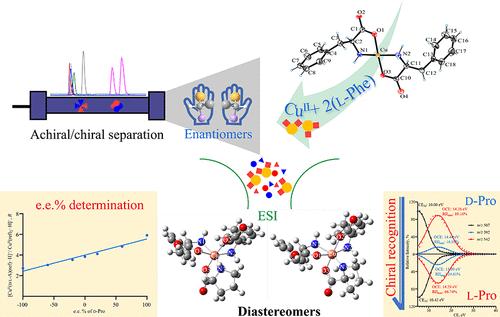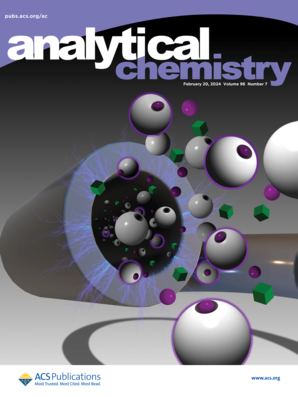[CuII(l-Phe)2–H]+ Complex: A Versatile Selector for Wide Enantiomeric Excess Determination and Chiral Recognition in Complicated Matrices by Post-column Infusion LC–Energy-resolved MS/MS
IF 6.7
1区 化学
Q1 CHEMISTRY, ANALYTICAL
引用次数: 0
Abstract
Enantiomeric measurement of complicated matrices always challenges LC–MS/MS. Efforts were made here to pursue a fit-for-purpose chiral selector (CS) for LC–MS/MS and to clarify the enantioselective mechanisms. After assaying diverse candidates for 22 pairs of enantiomers, differentiation was successful for 15 pairs when employing [CuII(l-Phe)2–H]+ as the CS. With d- vs l-proline (Pro) as representatives, diastereomeric complex ions such as [CuII(d-Pro)(l-Phe)2–H]+ and [CuII(l-Pro)(l-Phe)2–H]+ were formed and their featured fragment ions such as [CuII(d/l-Pro)(l-Phe)–H]+ and [CuII(l-Phe)2–H]+ exhibited different abundance ratios (R). R was linearly correlated with enantiomeric excess (ee %), and Rmax, termed as the R value at optimal collision energy, enabled chiral recognition. Crystallization was successful for both [CuII(d-Pro)(l-Phe)–2H] and [CuII(l-Phe)2–2H] complexes, and X-ray spectroscopy revealed that the distorted square planar configuration by tetrahedrally coordinating Cu2+ to two nitrogen atoms and two oxygen atoms from (Phe)2 or (d-Pro)(l-Phe) led to enantioselectivity. The diastereomeric complex was constructed by an octahedron core consisting of six spatially orthometric coordination bonds around nuclear CuII. ΔG differences for the generations of [CuII(d/l-Pro)(l-Phe)–H]+ and [CuII(l-Phe)2–H]+ contributed to enantioselective MS/MS behaviors. Because of mirror images between [CuII(d-Pro)(l-Phe)2–H]+ and [CuII(l-Pro)(d-Phe)2–H]+, l-Pro solely completed ee % determination. By correlating R to ee %, simultaneous ee % determination for nine pairs of amino acid (AA) enantiomers was reached in cell medium extracts. Through correlating Rmax to ΔG, chiral recognition, even configurational determination, was achieved for AA enantiomers and pyranocoumarin enantiomers in the complicated matrices. Together, [CuII(l-Phe)2–H]+ is an eligible CS to facilitate post-column infusion LC–energy-resolved MS/MS allowing wide ee % determination and chiral recognition in complicated samples.

求助全文
约1分钟内获得全文
求助全文
来源期刊

Analytical Chemistry
化学-分析化学
CiteScore
12.10
自引率
12.20%
发文量
1949
审稿时长
1.4 months
期刊介绍:
Analytical Chemistry, a peer-reviewed research journal, focuses on disseminating new and original knowledge across all branches of analytical chemistry. Fundamental articles may explore general principles of chemical measurement science and need not directly address existing or potential analytical methodology. They can be entirely theoretical or report experimental results. Contributions may cover various phases of analytical operations, including sampling, bioanalysis, electrochemistry, mass spectrometry, microscale and nanoscale systems, environmental analysis, separations, spectroscopy, chemical reactions and selectivity, instrumentation, imaging, surface analysis, and data processing. Papers discussing known analytical methods should present a significant, original application of the method, a notable improvement, or results on an important analyte.
 求助内容:
求助内容: 应助结果提醒方式:
应助结果提醒方式:


